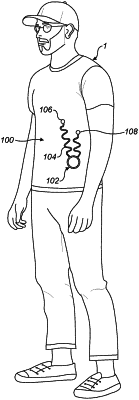| CPC A61B 5/256 (2021.01) [A61B 5/053 (2013.01); A61B 5/30 (2021.01); G06F 1/163 (2013.01)] | 22 Claims |

|
1. An electronic device for a wearable article, the electronic device being configured to receive biosignals from a sensor assembly provided on the wearable article and including one or more sensing electrodes, the electronic device comprising:
a housing having a base and a magnet, said housing arranged to house components configured to receive and process the received biosignals; and
a signal coupling mechanism configured, when the electronic device is attached to the wearable article at an electronic device interface of the sensor assembly, to couple the biosignals to the components from the sensor assembly,
wherein the signal coupling mechanism comprises at least one contact coupled to the components and configured to engage with the sensor assembly at a terminal of a respective sensing electrode, and
wherein the at least one contact is an electrical contact positioned in the housing in a first position that flexes into a second position outside of the housing due to the forces exerted by the magnet on the at least one contact; and the at least one contact engages with the terminal of the respective sensing electrode when the electronic device is attached to the wearable article;
wherein the housing includes at least one aperture in the base through which a portion of the at least one contact extends to engage with the terminal of the respective sensing electrode when in the second position.
|